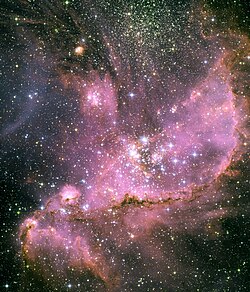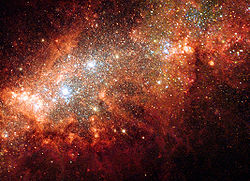Top Qs
Timeline
Chat
Perspective
Super star cluster
Type of very massive young open cluster thought to be the precursor of a globular cluster From Wikipedia, the free encyclopedia
Remove ads
A super star cluster (SSC) is a very massive young open cluster that is thought to be the precursor of a globular cluster.[1] These clusters called "super" because they are relatively more luminous and contain more mass than other young star clusters.[2] The SSC, however, does not have to physically be larger than other clusters of lower mass and luminosity.[3] They typically contain a very large number of young, massive stars that ionize a surrounding HII region or a so-called "Ultra dense HII region (UDHII)" in the Milky Way Galaxy[4] or in other galaxies (however, SSCs do not always have to be inside an HII region). An SSC's HII region is in turn surrounded by a cocoon of dust. In many cases, the stars and the HII regions will be invisible to observations in certain wavelengths of light, such as the visible spectrum, due to high levels of extinction. As a result, the youngest SSCs are best observed and photographed in radio and infrared.[5] SSCs, such as Westerlund 1 (Wd1), have been found in the Milky Way Galaxy.[6] However, most have been observed in farther regions of the universe. In the galaxy M82 alone, 197 young SSCs have been observed and identified using the Hubble Space Telescope.[7]

Generally, SSCs have been seen to form in the interactions between galaxies and in regions of high amounts of star formation with high enough pressures to satisfy the properties needed for the formation of a star cluster.[2] These regions can include newer galaxies with much new star formation, dwarf starburst galaxies,[8] arms of a spiral galaxy that have a high star formation rate, and in the merging of galaxies. In an Astronomical Journal published in 1996, using pictures taken in the ultraviolet (UV) spectrum by the Hubble Space Telescope of star-forming rings in five different barred galaxies, numerous star clusters were found in clumps within the rings which had high rates of star formation. These clusters were found to have masses of about 103 M☉ to 105 M☉, ages of about 100 Myr, and radii of about 5 pc, and are thought to evolve into globular clusters later in their lifetimes.[9] These properties match those found in SSCs.
Remove ads
Characteristics and properties
The typical characteristics and properties of SSCs:
- Mass 105 M☉[2]
- Radius ≈ 5 pc ≈ 1019 cm[2]
- Age ≈ 100 Myr[2] (although other sources state that observed SSCs have an age of 1 Gyr[3])
- Large electron densities = 103–106 cm−3 (this is a property of the HII region associated with the SSC)
- Pressures = 107–1010 K⋅cm−3.[5] (this is a property of the HII region associated with the SSC)
Remove ads
Hubble Space Telescope contributions
Given the relatively small size of SSCs compared to their host galaxies, astronomers have had trouble finding them in the past due to the limited resolution of the ground-based and space telescopes at the time. With the introduction of the Hubble Space Telescope (HST) in the 1990s, finding SSCs (as well as other astronomical objects) became much easier thanks to the higher resolution of the HST (angular resolution of ~1/10 arcsecond[10]). This has not only allowed astronomers to see SSCs, but also allowed for them to measure their properties as well as the properties of the individual stars within the SSC. Recently, a massive star, Westerlund 1-26, was discovered in the SSC Westerlund 1 in the Milky Way. The radius of this star is thought to be larger than the radius of Jupiter's orbit around the Sun.[11] Essentially, the HST searches the night sky, specifically nearby galaxies, for star clusters and "dense stellar objects" to see if any have the properties similar to that of a SSC or an object that would, in its lifetime, evolve into a globular cluster.[3]
Remove ads
List of SSCs
References
External links
Wikiwand - on
Seamless Wikipedia browsing. On steroids.
Remove ads














